American Fast Food In Japan
Top Photo by Blake Guidry on Unsplash
So say you’re from the US (for example) and just moved to Japan, and you’re not ready to dive right into Japanese food yet. You want your Baconator? Big Mac? Whopper? How about KFC? Japan is a wonderful country with wonderful food choices from ramen, sushi, takoyaki and other delicious meals.
However, there are just times when you’re not ready to experiment with food you’ve “heard” will be good, and you want to stick to something reliable. Here’s your quick guide to your fast food favorites. Mostly found in major cities like Tokyo, but sometimes they turn up in the oddest places.
Many of your favorites are actually here and very easy to find. The menus will have special
items not in the US. There’s things like teriyaki burgers, samurai burgers, and avocado burgers. Domino’s has special pizza bowls not sold in the states, and basically every pizza place has toppings and flavors you’ve never dreamed of.

Photo by Brett Jordan on Unsplash
Japan has Wendy’s, Mcdonald’s, Burger King, KFC, Taco Bell, Carl’s Jr, Dominos, Pizza
Hut and Subway. Most of these are in Tokyo. You can find the golden arches in most locations, even the countryside. Taco Bell can be found in Shibuya. Carl’s Jr is in Akihabara alongside Mickey D’s. And KFC is everywhere- it didn’t become synonymous with Christmas in Japan for nothing.
Don’t be surprised to find many of your favorites even if you don’t expect them. Some chains like Popeye’s are also in Japan, but only on US military bases. Recently, American-style Chinese food chains such as Panda Express and Shanghai Kitchen have been making a return in select major malls such as in Kawasaki and Okayama.
I love Japanese food, but sometimes I just want some good old junk food from home. The prices are similar but the sizes are generally smaller. You may find the establishments cleaner and service will be quicker than in the USA. They have apps to get special deals on food as well. Make sure you try some of the exclusive to Japan items on the menu! Just make sure you don’t eat it too much- calories are universal, no matter where you go.
Happy eating!
Photo Credits:
Top Photo by Blake Guidry on Unsplash used under the Unsplash License
Additional photo by Brett Jordan on Unsplash used under the Unsplash License
All other content (text) created by the original author and © 2022 MUSUBI by Borderlink
Top Photo: ぱくぱく89さん on PhotoAC
Have you ever done something that sounded good at first then maybe not so good when you are right in the middle of doing it? Me vs. Mt. Fuji would be a great example of that. It had always been on my bucket list, but I really had no idea just how demanding the climb would actually be. The journey to the highest point in Japan is a story in itself. And this is that story.
“Hey Honey, Let’s Climb Mt. Fuji!”
So it all started when my wife were talking about how hot it was, and my son thought and came up with the idea of climbing Mt. Fuji. While I wasn’t keen on the idea, my wife decided that was the best answer to the heat.
A few weeks later, I found myself at Station 5, the base of Mt. Fuji, after a train and bus ride. We bought our walking sticks that you can take to each station, and they will even brand it for you so you have a nice souvenir. Then on up to Station 6 where we had reservations to stay the night. The rooms were basically like big capsule hotels with only a curtain for a door. It was rather snug for the three of us, but we made it work.
Later in evening I went and sat outside, and was amazed at the view. I could see the lights of Tokyo when I looked out from the mountain and saw so many stars when I looked up in the sky. It made me smile when I looked up the mountain and saw what looked like lightning bugs, only to realize that they were hikers using head lamps to climb at night.
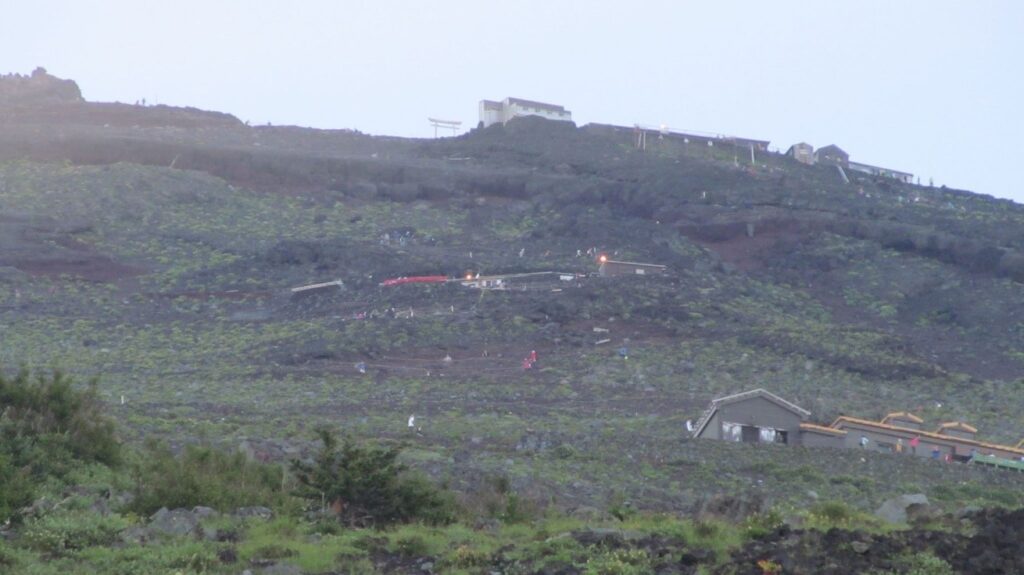
What Goes Up…
We slept well, other than the man across the way snoring loud enough to shake the whole cabin.
There are 4 trails (Yoshida, Subashiri, Gotemba, and the Fujinomia) that you can take to reach the summit. After breakfast, we hit the Fujinomia trail a little after 6 in the morning.
I was a little surprised because I had heard that there were always a lot of people going up and that it would be crowded. Maybe we just got lucky that day, because going up was very pleasant. We stopped at every station and rested for about 20 minutes, drank and ate a little.
Finally, we made it to the top of Fuji. There is a post office where one can buy and send postcards from Mt. Fuji. We sat there and talked with other people who had made it to the top and shared our experiences. Then it was time to make our way down. And that’s when things started going bad for me.
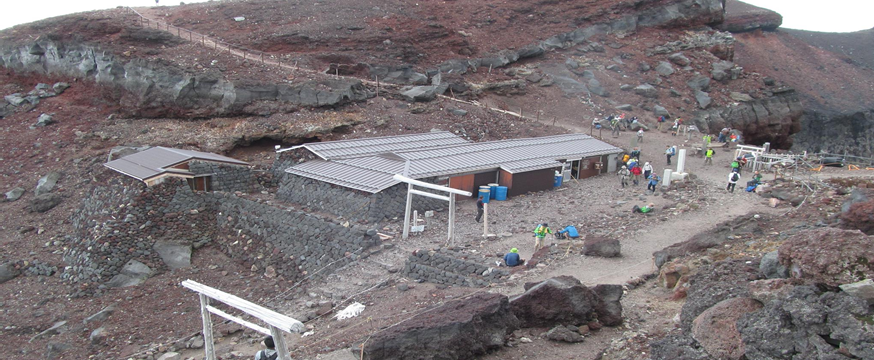
…Comes Tumbling Down
After we posted our postcards, we started our way down. I noticed my vision was getting blurry, like when you stand up too quickly. I knew it was the beginning of altitude sickness, but I was on my way down so I just needed to get down lower.
That cleared up a few minutes later, but then I noticed pain in both my upper legs and hips. The further I went the worse the pain got. I was thinking “Am I going to make it down from here?”. After several hours of what felt like extreme pain, I made it down, although the last 100 meters I could barely walk. The buses had already left so we grabbed a cab to get to the Shin station. I sat in the cab and didn’t move a muscle for the 1-hour drive. We got to the station and somehow, I survived.
It’s been 6 years since I took on Mt. Fuji and won. I look back now and smile because it was the most physically-demanding thing that I have ever done. While I probably wouldn’t try again, I am so happy that I did it. When people ask me about it, I always encourage them to climb it at least once. It’s not going to be easy, and it may hurt, but like many of the best things in life, it’s worth it.
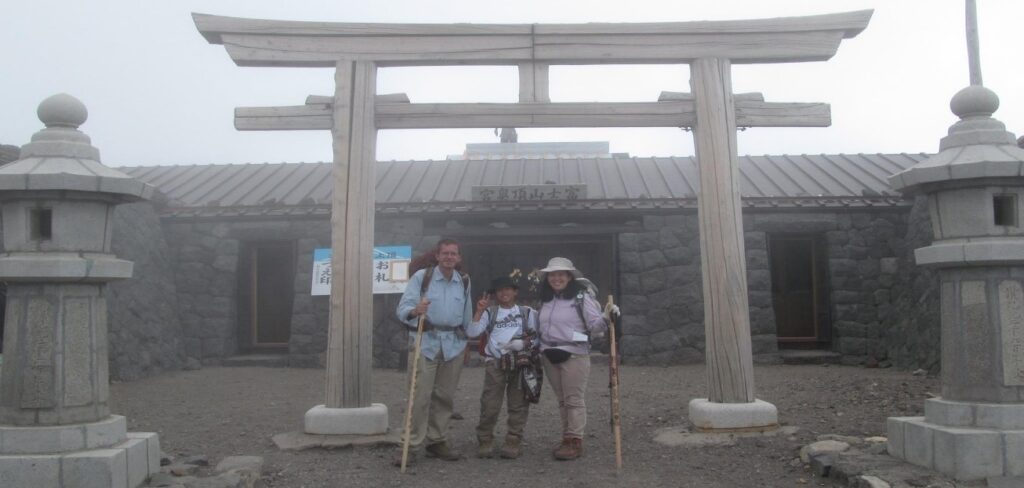
Photo Credits
Top Photo: ぱくぱく89さん on PhotoAC
All additional images taken and provided by Jason Killingsworth, used with permission.
All other content (text) created by the original author and © 2022 MUSUBI by Borderlink
Top Photo: crea33さん on PhotoAC
Japan has always had strong Buddhist roots that persist to the present day. For this reason, eating meat was once a upon a time quite taboo for much of Japan’s history. As an island nation however, they have always had fish as a plentiful alternative supply of protein. But what leaves some curious is why fish is often served raw in Japan as opposed to the rest of its global counterparts. Well, wonder no more!
What is Washoku?
We typically recognize Japanese raw fish as ‘sushi’ and ‘sashimi’. However, the name for traditional Japanese cuisine of raw fish is actually ‘Washoku’. Washoku culture dates back as far as 4000-5000 years ago within the Jomon period. [1] This tradition continues to be held widespread throughout the country. It has even recently been officially approved as a member of UNESCO Intangible Cultural Heritage. [2]
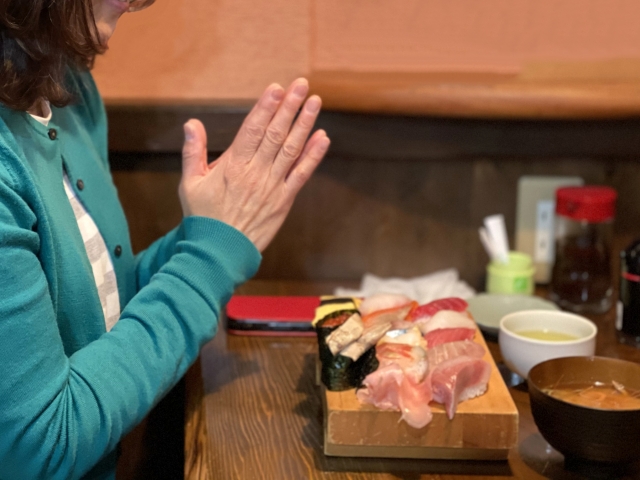
Photo by himawariinさん
But Why Raw?
Why does Japan often prepare fish raw? The answer partly lies in the introduction of Buddhism in the country during the 7th and 8th century. In Buddhism, killing animals for consumption is traditionally considered uncompassionate. As a result, meat consumption within Japan was greatly reduced and the nation had become largely a pescatarian nation. Within that time, the Washoku culture, known for its preparation of raw fish, had become more prevalent and further moulded the Japanese culture. [1]
So Why Eat Washoku?
So, are there any benefits of eating fish raw as opposed to cooked? It may be considered in some circles to be unhealthy to eat fish raw, yet ironically it is actually even healthier than its cooked counterpart. This is due to the fact that fish are filled with Vitamin D and omega-3 fatty acids, both of which are important for immunity, fertility and heart function. During the cooking process, both Vitamin D and omega-3 fatty acids are partially lost due to their sensitivity to high heat. By eating the fish raw however, the consumer will retain much of the original nutritional content.[3]
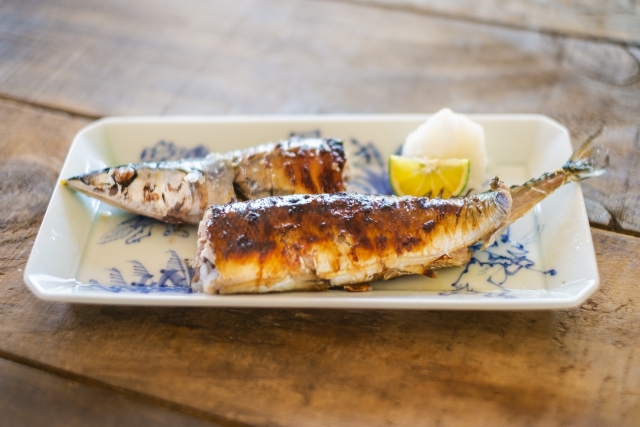
Photo by cheetahさん
But Is It Safe?
What makes raw fish safe for consumption? When is it not safe? The key is in the freshness of the fish. Luckily since Japan is an island nation, fresh fish is always available and ready to be sold immediately to markets for preparation. If the fish are not fresh, markets will strictly deem them unsuitable for sushi or sashimi preparation. Interestingly, eating habits can also influence the safety of raw fish consumption. Such habits include eating raw fish with soy sauce and wasabi, as both possess bactericidal properties, thereby further killing any remaining bacteria.[3]
Conclusion
The historical significance of raw fish in Japan remains largely unknown to the global population. Even with all the accessible information regarding health benefits of what we eat, a large number of people are still unaware of the nutrition they either consume regularly or don’t consume a lot of. It can therefore be quite easy for the general population to be skeptical of eating raw fish.
But Japan has a long track record for highest average life expectancy (currently 2nd behind Hong Kong SAR, China). The strong health benefits of eating raw fish suggests that this may have played a strong role in promoting long-term health in the Japanese people. Although not to everyone’s taste, occasionally substituting cooked fish with its fresh raw counterpart could prove to be a game changer in one’s life for healthy eating.
Photo and Information Credits:
Photos:
Top Photo: crea33さん on PhotoAC
1 – himawariinさん on PhotoAC
Articles cited:
1. https://japanyugen.com/the-reason-why-the-japanese-eat-raw-fish/#History_of_Eating_Raw_Fish_in_Japan
2. https://www.tokyoweekender.com/2013/12/japanese-cuisine-recognized-as-unesco-intangible-cultural-heritage/
3. https://japantruly.com/why-japanese-eat-raw-fish/
All other content (text) created by the original author and © 2022 MUSUBI by Borderlink
Have you ever encountered a situation where you feel like some rare animal breed being eyed by everyone around you? Or doing something so “normal” yet so embarrassing at the same time that your face transforms into a tomato?
Unfortunately (or is it?) I have. Let me share all the unspoken rules of Japan that I know and broke for you. As said by John C. Maxwell “A wise person learns from his mistakes. A wiser one learns from others’ mistakes.”
So, let’s dive into the topic, shall we?
Don’t eat and drink while walking
Pretty obvious “unspoken rule”, don’t you think? But not for me! Long story short, in my home country it’s normal to eat and drink while going one’s way to work. So, I did the same in Japan and next thing you know I had people looking left and right with raised eyebrows especially the oba-chans! Scary. So, I eventually changed that habit.
Truth be told, this is one that is beginning to change, as more and more you may see people partaking in certain foods while walking (such as ice cream or other festival fare). But these are still the exceptions, rather than the rule. And honestly, it’s much cleaner to not eat on the go (and if you don’t agree with that, you’ve obviously never walked into someone and spilt coffee all over yourself!)
Don’t tip! Again, don’t tip!!
Unlike in other countries where tipping staff for excellent service provided is considered normal. In Japan it’s viewed rudely and insulting to the working staff. Because they believe that it’s only normal to provide the best service they have and with you tipping them for their good service means in other times they are bad? So don’t tip! Be stingy! (also, as you may soon notice being in Japan, prices can generally be higher than in other countries, and part of that is going to wages. So don’t worry about the tip- your server gets a little more thanks to that fancy 1500 yen burger!)
Japanese Time
You know it. I know it. Every person who has worked in Japan knows it. Always remember, your “starting time” is 30 minutes before your “start” time. If you start at 8:30, get there by 8:00.
Face is a very BIG and important thing
This is mostly observed at working environments especially schools (based on my experience) and office because of position and seniority hierarchy. If you notice a co-colleague or more importantly a senior making a mistake even if it’s obvious. It’s still better to remind them of it privately and in a subtle but clear way. I think most people don’t want to be embarrassed as it is, but in many east Asian cultures in particular, saving face is a very big matter.
Be mindful of who you’re seen with
In Japan, it doesn’t always mean that going out alone with a colleague of the opposite gender is considered dating. But many people (especially in schools) still view it as such. So, if you can, prevent it. It’s always best to invite other people to make it more casual and to not make you embarrassed when the whole school staff looks at you weirdly. You know the term “wingman”? Well, make sure you have one!
Even if it’s you that are being invited, it’s still best to politely decline or ask others to accompany you, so as not to attract unwanted attention. There are plenty of exceptions to this “rule” so think of it more like a guideline, but still a good one to follow.
Give Back
When someone gives you a present, it’s best to reciprocate or at least give a token of appreciation. This is fairly common in all cultures, but especially the case in Japan. Always be ready to pay back a gift with another one (even if it’s as simple as chocolates or cookies). For example, if one of your coworkers brings omiyage (souvenirs) from a trip, make sure you do the same when you take a trip of your own.
Use Sick Leave Sparingly
In Japanese work culture, even if you have a mild cold, as long as you’re not bedridden, it’s still expected that you go to the hospital, get some medication, and come to work once you’re able to. Of course, if it’s something serious like a flu or a very high fever then feel free to call for sick leave. Remember every sick leave you take is someone doing your work for you (that’s what they say, don’t judge me!). It may sound absurd, but it’s still the case. Just take it with a grain of salt.
This is another rule that is somewhat on the decline thanks to COVID. If you have even a small fever, chances are work doesn’t want you to come in now. So take it on more of a case-by-case basis.
That’s all I have! Obviously, there’s still plenty of “unspoken rules” I haven’t mentioned. But it’s because most of them just point to one thing: “do not inconvenience others”. In Japan, as much as possible, don’t inconvenience others. Respect everyone’s time, and respect their boundaries. Embrace this mindset, let it envelope you, and soon you will find that Japan is pretty much “rule-free”!
Photo Credits:
All other content (text) created by the original author and © 2022 MUSUBI by Borderlink
Top Photo: Berutaさん on PhotoAC
Staying healthy is what we need to survive everyday. As we age, we should switch our lifestyle into something new from what it was before. When we were young, we tended to eat anything we like, regardless of what it does to our body. And when we talk about being healthy, we are not only focusing on our physical needs, but our mental health as well. But how do we stay healthy physically and mentally? It is very easy, we just need to follow a few simple steps.
I did not have enough knowledge about healthy living until I had my annual check up 2 years ago. and the results were not good. I was referred to an Internal Medicine Specialist in Tokyo for further check-up and treatment because I had issues with my blood sugar, cholesterol and uric acid. My weight was even below normal and I have always had normal blood pressure. Still, issues persisted. My doctor advised me to change a few things and have a healthier lifestyle. As I learned, we need to eat healthy food, have enough sleep and relaxation, and do regular exercise.
Eating Healthier
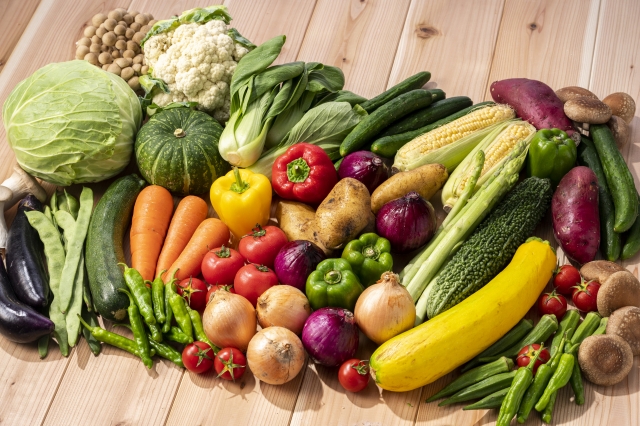
Photo Credit: チリーズさん
Let us talk first about the food that we are going to eat in order to have a healthy body. What are we supposed to eat? What are those healthy foods? Each of us has different requirements when it comes to healthy foods. Especially as we get older, we become very particular about watching our sugar, cholesterol or calorie intake.
For people who are always on the go, or in their busy working age, healthy food means eating 3 healthy regular meals everyday. I am talking about breakfast, lunch and dinner. For every meal, it should consist of healthy foods such as vegetables or fruits for fiber, which is very important. Grains, fat free dairy, lean meats, fish, eggs & nuts are also part of a balanced diet.
We should choose foods that are low in cholesterol and just eat in moderation. We should also check the labels of the products carefully. Foods to avoid? We just have to control the soda intake if we can not avoid it. Soda is not a healthy drink. Switch to water. We can never go wrong with water. How about coffee? Coffee is good but with too much sugar, it is not good. Sugar promotes weight gain and obesity, it affects your mood and increases your risks of diabetes and cardiovascular diseases.
And please do remember that of all the meals that we are going to prepare, dinner does not have to be the largest serving. We should avoid eating large meals before sleeping.
Sleep Enough
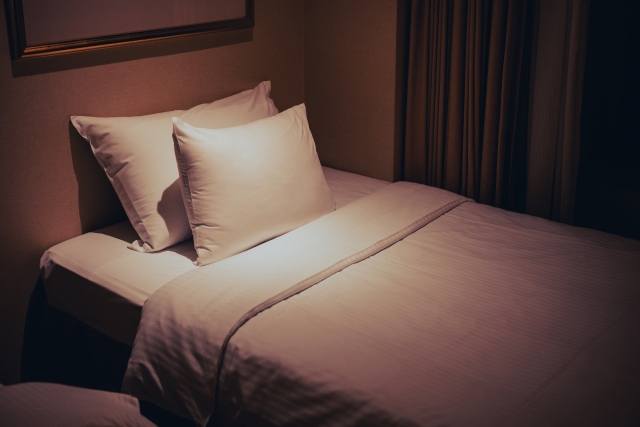
Photo Credit: Yoshi.Yuさん
The number two requirement to be healthy is to have enough sleep. How many hours does a person needs to sleep to maintain good health? Like food, the requirement also varies according to age. According to the National Sleep Foundation guidelines, adults or even those 65 years and above need 7 to 8 hours of sleep per night. On the flip side, babies or even teens need more hours to enable their growth and development.
How do we get enough sleep or how to have a better sleep? Some tips from a doctor from my home country: No mental work after 6:00 pm; do not schedule early morning meetings as it is hard for you to sleep at night; get a good mattress; take a warm drink or light snack; try supplements; make your body tired; meditate; listen to music and have a massage; or just count your blessings and pray.
Exercise More
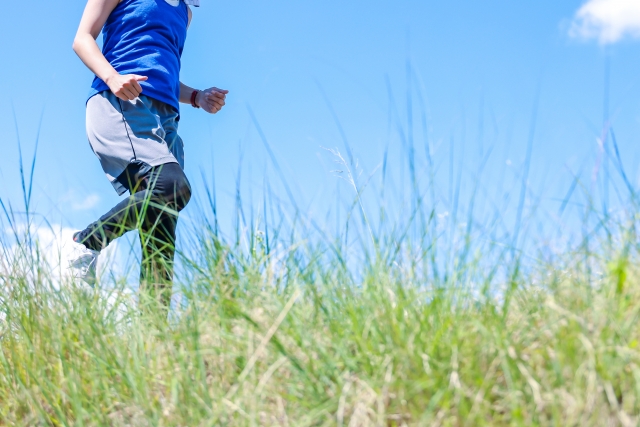
Photo Credit: hacksbackさん
And lastly, in order to have a completely healthy lifestyle, we need to have regular exercise or physical activity. This is very important to have normal blood circulation because it helps you to de-stress after a longl day at work. It improves your mood which is good for your mental health and emotional well-being.
Plus, it helps you feel better, when you have regular blood circulation, it keeps your heart and your brain sharp. It shows in your physical appearance: you look good and feel good, and it can boost your confidence and improve your self-esteem.
There are many things to consider when choosing a healthy lifestyle. Everything should be taken in moderation, because too much is not good. Too much alcohol is bad for your health. Smoking is a bad habit. Your heart and lungs will be at risk. Too much stress must be avoided.
A healthy lifestyle is not only about how to avoid sickness, but also about maintaining your physical, social and mental aspects to live and enjoy a longer meaningful life. And, with a little planning and common sense, you can do it on the cheap too!
Photo Credits:
Top Photo: Berutaさん on PhotoAC
All other content (text) created by the original author and © 2022 MUSUBI by Borderlink
Nagareyama is a suburban area beside the Edogawa River with a lot of good history. If you like walking, sightseeing and listening to good stories, add Nagareyama in your list.
I went to Nagareyama through a group tour organized by Matsudo International Exchange Association (MIEA). The meeting area was in Matsudo station and from there we took the train going to Mabashi Station. Once you’re out of Mabashi Station transferring to Ryutetsu-Nagareyama Line, you will enter an invisible portal to the past. There will be no IC Card Reader and the platform ceiling is wooden. To buy a ticket, you need to bring cash and since it wasn’t a very busy train line, waiting time is longer than the usual lines you’re used to. The train ride from Mabashi station to Nagareyama was also a blast. I felt like I paid 200 yen for a roller coaster ride except that it didn’t go to a spiral. It wasn’t scary, it was actually fun.
From Nagareyama station, we were met by the tour guides who would accompany us through the whole walk around Nagareyama Honcho area. Nagareyama offers tours in English, Chinese, Spanish and French.
Ryutetsu Mural Project
The first place that we walked through is a street along a 100m mural by British artist, locals and children. The mural is an ode to Nagareyama depicting what Nagareyama is like through the eyes of a foreigner.
Kura no café and gallery Towa
It was built 100 years ago and is now renovated to be a café and gallery to preserve the building’s structure. Mirin themed food and drinks are their recommended menu that everyone must try. Sadly, I wasn’t able to try it myself, but because Mirin is a pride of Nagareyama, my expectations are high.
Sengen Shrine
Sengen Shrine has a Fujizuka behind it where it is said that if you climb to the top, you will get the same blessing as if you climb Mt. Fuji itself without actually climbing it. It is a great place especially for those who can’t physically climb Mt. Fuji but wanted to be blessed.
Enma Shrine
Enma is the God of Hell and the one who judges you in the afterlife. In here, you can pray to Enma to spare you from hell especially if you have committed a lot of sins. Across Enma’s shrine is the grave of Ichinojo Kaneko and his lover, Michitose. Ichinojo Kaneko is a virtuous thief that is quite similar to Robin Hood, but is a famous character in Kabuki plays.
Kondo Isami Jinya ato (Remains of Kondo Isami’s Encampment)
When we approached this area just a very short walk from Enma Shrine, we were told to gather around. It was story telling time. It was also our rest time from walking. The tour guide told us the story about how Kondo Isami and his subordinates came to Nagareyama, how he was caught and eventually died while being true to his principles. Beside this area, is a small store where you can buy souvenirs and drinks.
Nagareyama Honcho Open-air museum
Here lies a factory with more than 200 years of history. On the outside, there are large photos in panels showing the history of White Mirin to celebrate its 200th year. Originally, Mirin was a darker color, but this is where the white mirin was born and has been one of the reasons why Nagareyama prospered.
Issa-Soju Memorial Hall
This is opened to commemorate the friendship between Issa Kobayashi and Sanzaemon Akimoto who bonded over Haiku. This was our last resting stop before going to the last stop. Despite the afternoon heat that day, this area remained cool. The Memorial Hall is surrounded by trees and gravel. This is also where another story was told about the friendship between Kobayashi and Akimoto.
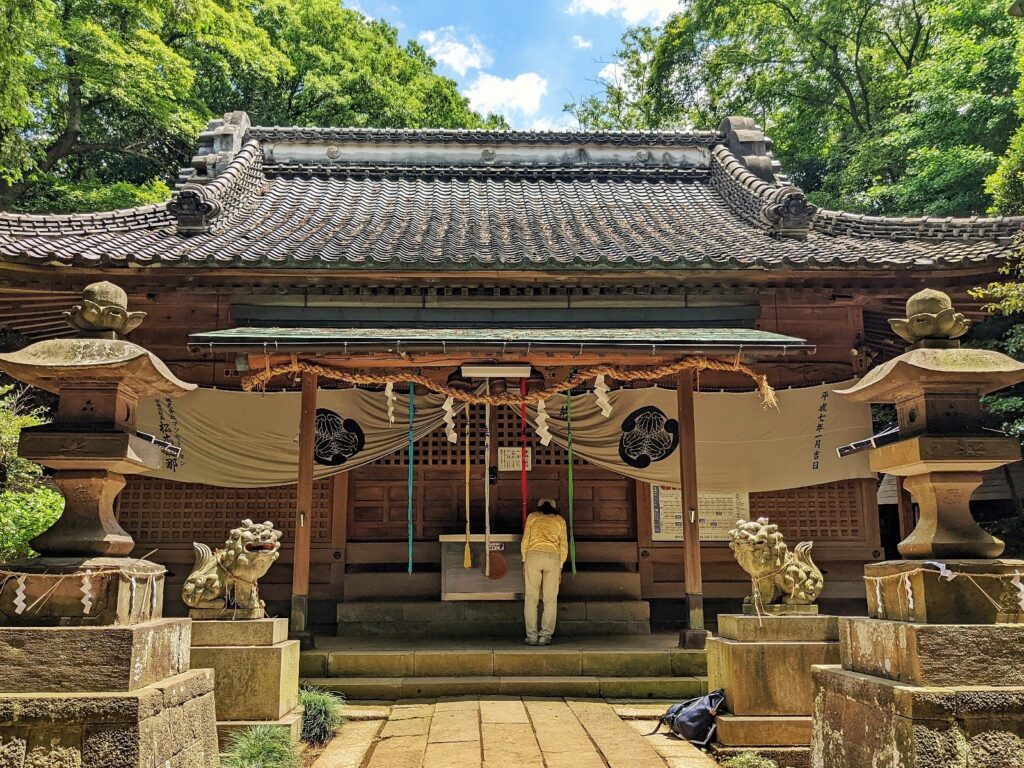
Akagi Shrine. Photo provided by Rei Hiramatsu.
Akagi Shrine
This shrine is known for its Shimenawa that weighs around 500kg. The Shimenawa is placed at the entrance of the shrine to serve as a division between the sacred grounds of the shrine and the common grounds that we all live in. Shimenawa has become their pride not because it weighs 500kg but because of the process it goes through before it gets hung.
The hill side of the Akagi Shrine is also said to be soil and lava that drifted from Gunma when Mt. Akagi erupted. On the top of the hill is a shrine where you can ring the bell and pray. Downstairs on the right side, there is a tree that symbolizes the post office where you can write on the back of the leaves.
Conclusion
The tour ended with us walking on our way to the station. It was a hot but fun walk that I didn’t even notice that we’ve been walking for 3 hours under the afternoon sun. There are a lot of stories to hear from the guides themselves. Go when you have a lot of time as there are a lot of places, food and such to see and try that you can’t possibly explore in a short time. If you’re interested in a place with sites with rich history, don’t forget to visit Nagareyama!
Photo Credits:
All additional images taken and provided by Rei Hiramatsu, used with permission.
All other content (text) created by the original author and © 2022 MUSUBI by Borderlink
Kushikatsu, and where to find it
Deep into the land of the rising sun. In the busy streets of Osaka. Among the many street foods you will find like Takoyaki and Okonomiyaki. There is a food that is often overlooked. Kushikatsu might just be one of the best foods you’ll find in Osaka。
So what is Kushikatsu?
“Kushi” are the skewers made from bamboo. And “katsu” are the meat cutlets usually beef that are often found in many other Japanese foods. The cutlets are places on the skewer. Then they are breaded and deep fried. Now our Kushikatsu is ready to be dipped in the sweet Kushikatsu sauce then enjoyed.
Sure, but what if I’m vegan?
Well, you’re just in luck. Despite the name, Kushikatsu restaurants offer more than just beef cutlets. Many vegetables like eggplant, green peppers, asparagus, and more are very popular in many Kushikatsu restaurants。
But it doesn’t stop there. Kushikatsu can also be served up as eggs, cheese, chicken and other delicious foods. Just remember the golden rule once you are ready to eat that’s the same everywhere else in relation to chips and dip. NEVER EVER DOUBLE DIP. The sweet sauce may come in one container meant for everyone at the table. But even if it doesn’t. It’s still considered bad manners to double dip in Japan.
So where can I find the best Kushikatsu restaurants?
As to be expected, probably the best place to get the best Kushikatsu is its birthplace. Osaka Japan. But slow down partner. You can’t just get it from anywhere. Any Osaka native knows you won’t find the best Kushikatsu in Namba or Shinsaibashi areas. You’ll have to go to a place called Shinsekai (New world).
Shinsekai may not look like much in the daytime. But at night the streets come alive and the lights from all the restaurants and game street venders is beautiful to look at. It’s here most restaurants serve delicious Kushikatsu. Whether you’re on a couple’s date or a night out with your friends. Shinsekai is an amazing place to see the sights. And of course, eat lots of Kushikatsu!
Photo Credits:
All other content (text) created by the original author and © 2022 MUSUBI by Borderlink
An unconventional guide to making friends in Japan as a newcomer.
PLEASE READ THIS FIRST
Alright, I’m just going to say that this might not work for everyone. In fact it probably works only for a very small percentage of people. Appearance, fashion sense and how socially awkward you are will probably affect your results when using these techniques. The below are just tactics which I have employed personally and that have worked for me. The purpose of this blog article is really just for entertainment, food for thought and a peek into my personal experiences for the first 6 months of my life in Japan. I hope you find it useful. But if not, I hope I can at least make you laugh a little. Now on with the show!
About Me
I was born in Taiwan and immigrated to New Zealand at the age of 7. After 23 years of living comfortably as a New Zealand citizen, I decided to venture to a foreign country and challenge my survival capabilities in Japan. A country where I couldn’t speak the language of and had zero friends. I am 170 cm in height (average height in Japan for males), slimly built and I would say mediocre in athletic ability as well as physical appearance. I also happened to arrive in Japan only a couple months before COVID-19 hit, so the ways which I made friends were unconventional. Hence, this is an unconventional guide to making friends in Japan as a newcomer!
About Japanese People
Japanese people are great, of course. But there are many who will be cautiously hesitant, if not outright intimidated the first time you talk with them. Although I have met a handful of Japanese people who weren’t shy at all, many I’ve know took some time to break the proverbial ice with.
A lot of this comes down to the language barrier; I have lost track of how many times you can see that visible look of relief when your answer to the dreaded question of “Do you speak Japanese?” is a tired but friendly “yes”. Once you’re past that hurdle, things are usually pretty smooth. It’s always important to remember though that, like people in every country, folks in Japan have a method. It may not be what you’re used to, but once you figure it out, making friends becomes much easier than it was when you began.
Be Available
Now this is a general tip to making friends, not just in Japan, but anywhere. You want to position yourself in situations where others feel obligated to invite you to places when inviting other. They will feel pressured to invite you into their group outings due to 1) systemic politeness which has been drilled into them, but also 2) you’re hopefully en route to a genuine friendship, and they all got to start somewhere!
“But sir, I don’t know how to get myself into these situations”, is probably the question you are thinking to yourself right now. Luckily in Japan, share houses are common and popular among younger people and foreign residents alike. You want to find a shared house which has a common living area. Usually, before you move in, the house manager will take you through the house. Keep an eye out for social areas where people are playing, chatting or cooking together, as these are the goldmines you are looking for.
After your first outing with your new housemates, you are now awarded with authority to invite others on an outing. Congrats! Now it is no longer awkward for you to ask them to go to dinner or karaoke with you!
Be Remembered
If you’re a non-Asian foreigner, this part is probably easier. You stand out just by being you, and in a group, being one of of the group but different is a great quality to have. You know Chewbacca in Star Wars? Everybody likes Chewbacca, because he’s a big hairy guy who yells a lot, but also because he’s just one of the gang like everybody else. Be Chewie, is what I’m saying here. For those of us who ‘blend in’ more until we open our mouths, it can be harder in some ways (and easier than others), but it’s not impossible.
With that said, these tips can still help you build stronger rapport with your soon-to-be friends. No matter where you are from, humor is universal and everyone likes to have a laugh. Usually after a brief introduction of “Hi, I’m J.”, “I’m from New Zealand” etc, the first question which they will ask you without fail is “Can you speak Japanese?”. I like to reply with konohen no hana wa anata no tame ni saiteimasu この辺の花はあなたのために咲いています (the flowers here bloom for you).
Now I know what you are probably thinking. “WHAT!?” Well my friend, you are forgetting that you are (probably) not a native Japanese speaker, and I am (definitely) not a native Japanese speaker either. So to bust out a poetic line like that as a first impression? It’d be like going to an English-speaking country for the first time and introducing yourself by dropping a little Will Shakespeare on them.
I have done this (the flower like, not the Shakespeare) many times, and every time it has gotten a big laugh followed by “where did you learn that?” This creates a memorable moment for them, and they will probably tell their friends shortly after on LINE how this funny foreign fella just moved into the house and they’re pretty cool.
Remember Their Names
Japanese people know Japanese is difficult, because it is difficult for them too. So they understand it is extremely difficult for foreigners to remember their names. If you manage to remember their names within 1 meeting, they will be really impressed when you call them by their name the 2nd time you see them. It’s almost like a party trick, they will probably say something like sugoii ne. A trick to do this is to say their name 3 times during the first conversation. “Hi, Yuka” “What do you like? Yuka” “See you later, Yuka”.
And if you do forget, fear not! Ask them their family name, repeat it, and (if they don’t tell you their full name again) just use (family name)-san until they say you can use their first name, which they will then hopefully re-state for you. This also works in English, unless they’re those weird kinda people who address each other by last names. Who does that? If someone’s last name is “Miller” do you address them only as “Miller”? Unless your name is Alec Hardy, no you don’t.
Lastly: HOLD THE DOOR (HODOR)
That one was for the GoT fans out there.
This is probably something that is already natural to you growing up as a westerner, but I have only recently come to understand the full power of this gesture. Many Japanese men for some reason don’t hold the door open for others like we do in the western world. Traditionally, the concept of “ladies first” wasn’t much of a thing, though that has been changing over the years. When you deliberately hold the door open for others and let others pass through first, for many of them this is a new experience. They will think you are yasashii (kind). Which is probably the highest valued personality trait in Japanese society. You will be instantly likeable, and soon you will have more friends than you can count!
In Conclusion
Now, you are all probably asking “Just who does this guy think he is?”, “Does he have a lot of friends?” and “Is he even popular?”. The truth is, I’m not super-duper popular and I don’t have a boatload of friends. I also don’t really care about what you anonymous readers think anyway! Okay I’m kidding about the last part. Please don’t punch me in the face if we ever meet on the street some day.
I am just sharing my experience on how I have navigated around Japan and made friends during this period of COVID-19. Living in a new country by yourself can be extremely lonely, and it is important to have some people you can rely on. While I’ve only made a handful of friends, the ones I have made have been as warm and welcoming as any I had back home. It is possible to make friends in Japan: you just have to believe in yourself, and be a little outgoing (or be that kind of introvert who finds like-minded introverts and also ends up becoming friends).
As I said at the beginning, this was meant to be entertaining. Are you not entertained? Uh, don’t answer that.
Photo Credits:
